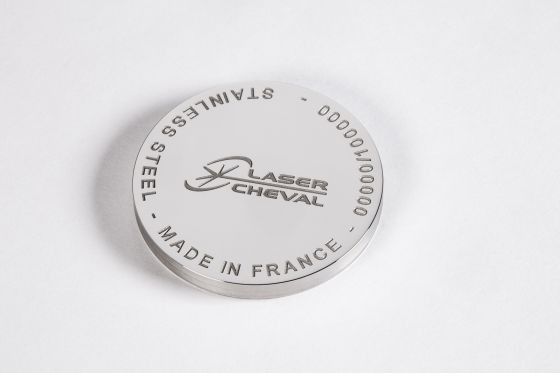Laser marking on metals, what you need to know
The production of decorations, logos, drawings, Datamatrix, barcodes, serial numbers and text by laser marking is a widely used process in the industrial sector. Laser Cheval has been specialising in laser marking for 40 years. The precision of its LEM, LEM SAPHIR or LEM QUARTZ or IOLITE laser machines enables it to meet every demand for laser marking on metals. Here is an overview of this technique, which improves the precision and productivity of companies.
What is laser marking and what is the difference with laser engraving?
- Metal is one of the materials that react very well to laser technology. Laser marking of metal is a process that is becoming increasingly popular in many industrial sectors. Laser marking consists of inscribing information on a part in an unalterable and precise manner, using a laser beam.
- Laser marking or laser engraving? What is the difference? Very often, laser marking and engraving are associated processes. But in reality, there are differences. While both applications refer to an unalterable mark on a material using a laser beam, engraving vaporises it while marking melts it. In metal marking, the heat of the laser melts the material and changes its shape to inscribe a permanent message.
- Laser engraving, on the other hand, vaporises the material. The laser beam penetrates deeper into the surface and sublimates the material by creating grooves. The latter technology takes longer than marking because it marks the metal more deeply, creating a raised result.
Which metals are suitable for laser marking?
Laser marking is suitable for "soft" metals such as aluminium as well as for very hard alloys or more noble metals such as gold and silver. The laser process is very often used on the following materials
- Precious metals (silver, gold etc.)
- Stainless steel
- Aluminium
- Hardened metals
- Alloy steel
- Titanium, titanium alloys
- Carbide
- Brass
- Copper
What are the advantages of laser marking on metals?
# Speed of execution
Laser is one of the fastest marking technologies. It is therefore perfectly suited to fast industrial rates. It can be easily integrated into a production line.
# Precision and aesthetics
The fineness of the laser beam enables information to be marked with precision. Compared to traditional techniques, the laser is able to reach an inaccessible area and create complex patterns or fine inscriptions.
# High resolution and durable marking
Laser marking is resistant to heat, wear and tear, abrasion, and the action of certain chemicals over time. This technique can therefore be used in difficult industrial environments. Laser marking has the advantage of not subjecting the material to any technical constraints. Simply placed under the laser beam, the part comes out intact, without being deformed.
# Multi-purpose technique
Laser marking on metal is suitable for all types of components.
>> Discover our range of machines to meet your laser marking needs
Why laser marking?
Laser marking on metal meets the needs and applications of various sectors of activity:
- Customisation: logo, symbol, text
- Serialization: serial numbers
- Traceability: alphanumeric references, bar codes, Datamatrix codes
- Decoration
Customising objects, meeting the requirements of industrial production monitoring, metalworking by laser marking offers many possibilities. More and more companies are using this process for the identification and traceability of their products. The precision of the laser also makes it possible to design more elaborate patterns.
Do you have a project to personalise your metal parts? Contact our Laser Cheval teams who will carefully study the feasibility of your project and provide you with the most suitable solution!
Contact us on +33(0)3 81 48 34 60 or by e-mail laser@lasercheval.fr





